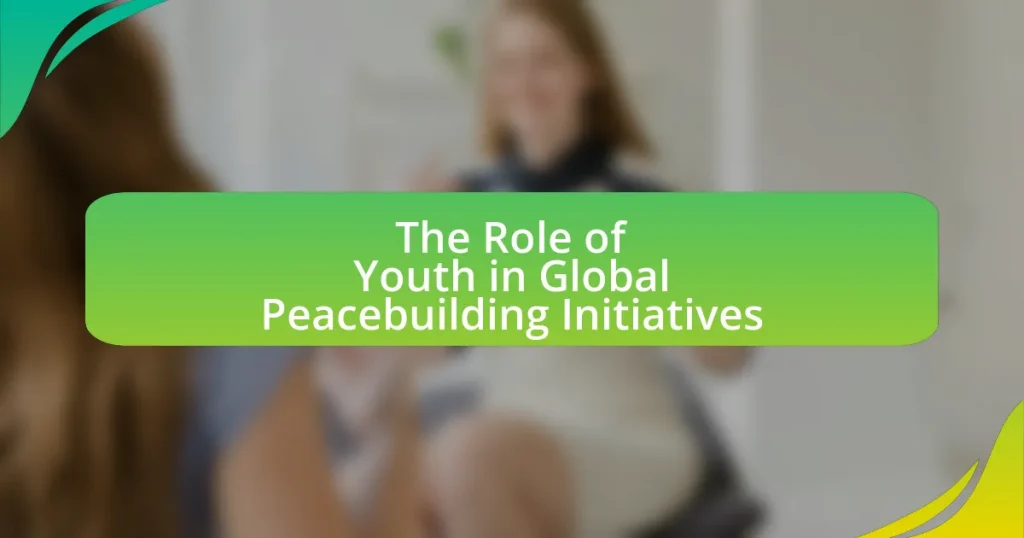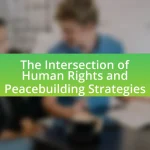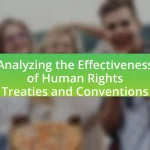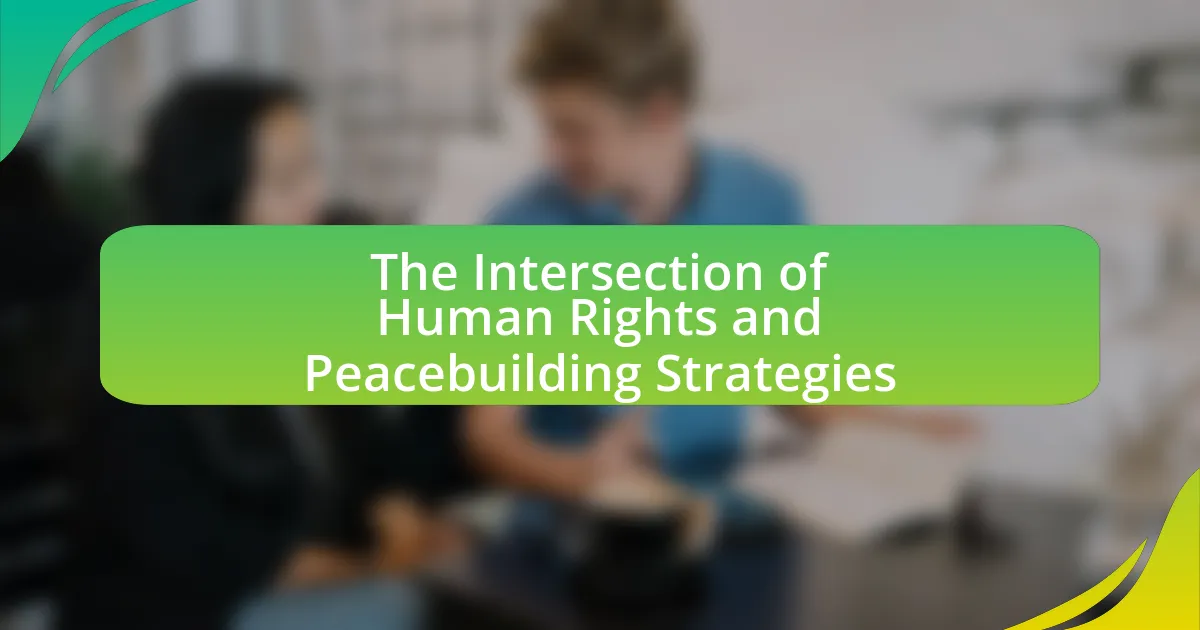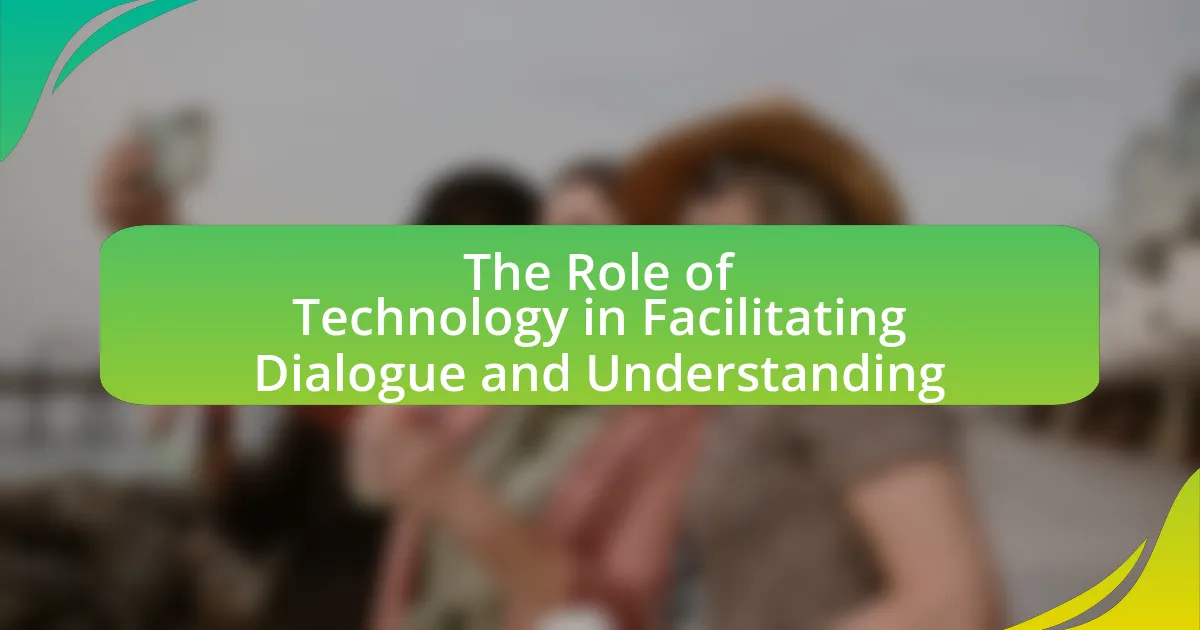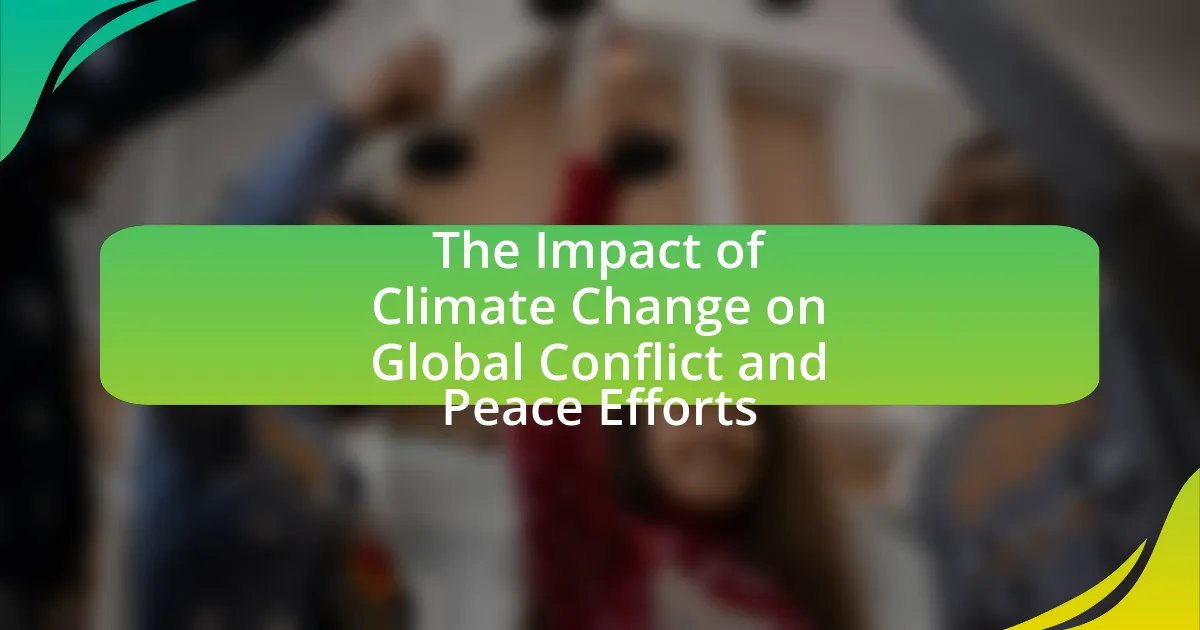The article examines the critical role of youth in global peacebuilding initiatives, highlighting their capacity as catalysts for change and advocates for social cohesion. It discusses the significance of youth involvement in peace processes, emphasizing their unique perspectives, innovative approaches, and the historical context of youth movements in shaping peace initiatives. The article also addresses the challenges youth face, such as limited access to resources and decision-making platforms, while outlining strategies to enhance their engagement and the importance of education and partnerships in empowering young peacebuilders.
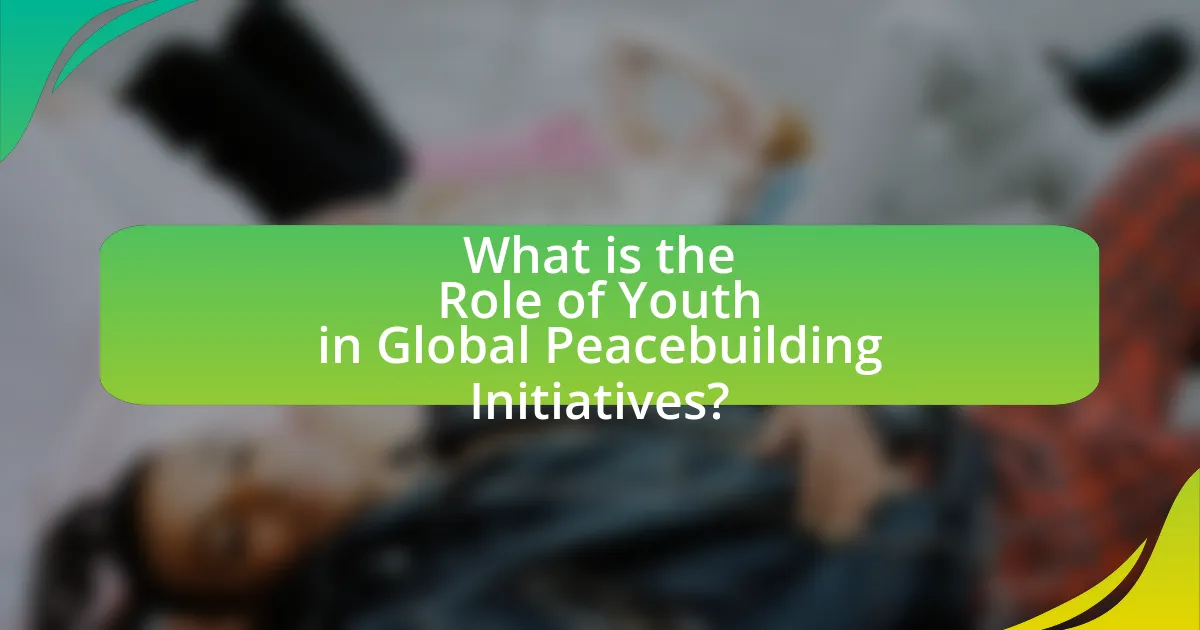
What is the Role of Youth in Global Peacebuilding Initiatives?
Youth play a crucial role in global peacebuilding initiatives by acting as catalysts for change and promoting social cohesion. They engage in advocacy, mobilize communities, and utilize technology to raise awareness about peace issues. For instance, the United Nations Security Council Resolution 2250 emphasizes the importance of youth in peace and security, recognizing their potential to contribute to conflict prevention and resolution. Furthermore, studies show that youth-led organizations often drive innovative solutions to local conflicts, demonstrating their effectiveness in fostering dialogue and understanding among diverse groups.
Why is youth involvement crucial in peacebuilding efforts?
Youth involvement is crucial in peacebuilding efforts because young people bring fresh perspectives, innovative ideas, and the ability to mobilize communities. Their engagement fosters inclusivity and ensures that peace initiatives address the needs and aspirations of future generations. Research by the United Nations indicates that youth are key agents of change, with over 1.8 billion individuals aged 15 to 29 globally, representing a significant demographic that can influence social norms and drive conflict resolution. Furthermore, studies show that when youth participate in peace processes, the likelihood of sustainable peace increases, as they often advocate for social justice, equality, and human rights, which are essential for long-term stability.
What unique perspectives do young people bring to peacebuilding?
Young people bring innovative and dynamic perspectives to peacebuilding, characterized by their adaptability, creativity, and commitment to social justice. Their unique experiences, shaped by contemporary issues such as climate change, digital communication, and global interconnectedness, enable them to approach conflict resolution with fresh ideas and solutions. For instance, a study by the United Nations in 2020 highlighted that youth-led initiatives often leverage technology to foster dialogue and mobilize communities, demonstrating their ability to engage diverse groups effectively. Additionally, young people tend to prioritize inclusivity and equity, advocating for marginalized voices in peace processes, which is crucial for sustainable peace.
How does youth engagement influence community dynamics?
Youth engagement significantly influences community dynamics by fostering social cohesion and encouraging active participation in decision-making processes. Engaged youth contribute fresh perspectives and innovative solutions to community challenges, which can lead to enhanced collaboration among diverse groups. For instance, research by the United Nations indicates that youth involvement in local governance can improve community trust and reduce social tensions, as seen in various peacebuilding initiatives worldwide. This active participation not only empowers young individuals but also strengthens the overall resilience of communities, making them more adaptable to change and conflict.
What are the historical contexts of youth in peacebuilding?
Youth have historically played a crucial role in peacebuilding, often acting as catalysts for social change and conflict resolution. For instance, during the anti-apartheid movement in South Africa, youth mobilized to challenge systemic oppression, demonstrating their capacity to influence political landscapes. Similarly, in the aftermath of the Rwandan Genocide, youth initiatives focused on reconciliation and rebuilding communities, highlighting their importance in post-conflict recovery. Furthermore, the United Nations Security Council Resolution 2250, adopted in 2015, explicitly recognizes the role of youth in peace and security, underscoring their historical significance in peacebuilding efforts globally.
How have youth movements shaped peace initiatives in the past?
Youth movements have significantly shaped peace initiatives in the past by mobilizing collective action and advocating for social change. For instance, the anti-apartheid movement in South Africa, led by youth organizations like the South African Students’ Organization, played a crucial role in dismantling apartheid through protests and international awareness campaigns. Additionally, the Arab Spring, which saw young activists using social media to organize protests, highlighted the power of youth in demanding political reform and peace in the Middle East. These movements demonstrate that youth can influence policy and promote peace by raising awareness, fostering dialogue, and challenging oppressive systems.
What lessons can be learned from previous youth-led peace efforts?
Previous youth-led peace efforts demonstrate the importance of inclusivity and grassroots engagement in conflict resolution. For instance, the 2011 Arab Spring highlighted how youth mobilization can challenge oppressive regimes and foster democratic movements. Additionally, the 2014 Youth Peace and Security Agenda, endorsed by the United Nations, emphasizes the need for youth participation in peace processes, recognizing that their perspectives can lead to more sustainable outcomes. These examples illustrate that empowering young people to take active roles in peacebuilding not only enhances the effectiveness of initiatives but also promotes long-term stability in communities.

How do youth participate in global peacebuilding initiatives?
Youth participate in global peacebuilding initiatives through advocacy, community engagement, and participation in decision-making processes. They often engage in grassroots movements, leveraging social media platforms to raise awareness about peace issues and mobilize their peers. For instance, organizations like the United Nations have recognized the importance of youth involvement, as evidenced by the UN Security Council Resolution 2250, which emphasizes the role of young people in peace and security efforts. Additionally, youth-led organizations, such as the Global Youth Peace Network, actively work to create dialogue and foster collaboration among diverse groups, demonstrating their commitment to building sustainable peace.
What roles do young people play in peacebuilding organizations?
Young people play crucial roles in peacebuilding organizations by serving as advocates, facilitators, and innovators. They engage in advocacy efforts to promote peace and social justice, often mobilizing their peers and communities to raise awareness about conflicts and peace initiatives. Additionally, young individuals frequently act as facilitators in dialogue processes, bridging gaps between different groups and fostering understanding. Their innovative approaches, often leveraging technology and social media, enable them to create new platforms for communication and collaboration in peacebuilding efforts. Research by the United Nations indicates that youth involvement in peace processes can lead to more sustainable outcomes, highlighting their importance in shaping a peaceful future.
How do youth contribute to policy-making processes?
Youth contribute to policy-making processes by actively engaging in advocacy, participating in consultations, and influencing decision-makers through organized movements. For instance, youth-led organizations often mobilize to address issues such as climate change, education, and social justice, thereby shaping policies that reflect their priorities. Research indicates that when young people are involved in policy discussions, they bring fresh perspectives and innovative solutions, which can lead to more effective and inclusive policies. A notable example is the United Nations’ Youth2030 strategy, which emphasizes the importance of youth participation in global decision-making, recognizing that their involvement is crucial for sustainable development and peacebuilding.
What skills do young peacebuilders develop through their involvement?
Young peacebuilders develop critical skills such as conflict resolution, communication, leadership, and teamwork through their involvement in peacebuilding initiatives. These skills are essential for effectively addressing and mitigating conflicts within their communities. For instance, conflict resolution skills enable young individuals to mediate disputes and foster understanding among diverse groups, while strong communication skills help them articulate their ideas and advocate for peace. Leadership abilities empower them to take initiative and inspire others, and teamwork skills facilitate collaboration with peers and organizations. Research by the United Nations indicates that youth engagement in peace processes enhances their capacity to contribute positively to societal stability and cohesion.
What platforms exist for youth to engage in peacebuilding?
Youth can engage in peacebuilding through various platforms such as the United Nations Youth Envoy, local and international NGOs, social media campaigns, and youth-led organizations like Peace First and the Global Youth Peace Network. These platforms provide opportunities for young people to participate in dialogue, advocacy, and community projects aimed at conflict resolution and promoting peace. For instance, the United Nations Youth Envoy focuses on amplifying youth voices in peace processes, while organizations like Peace First offer grants and resources for youth-led peace initiatives.
How do social media and technology facilitate youth activism?
Social media and technology facilitate youth activism by providing platforms for communication, organization, and mobilization. These digital tools enable young activists to share information rapidly, connect with like-minded individuals, and coordinate events on a global scale. For instance, the use of Twitter during the Arab Spring allowed youth to organize protests and disseminate information despite government censorship, demonstrating the power of social media in facilitating grassroots movements. Additionally, a study by the Pew Research Center found that 71% of young people use social media to engage with political issues, highlighting its role in shaping youth activism.
What are the benefits of youth-led organizations in peacebuilding?
Youth-led organizations play a crucial role in peacebuilding by fostering innovative solutions and promoting inclusivity. These organizations empower young people to actively participate in decision-making processes, ensuring that their perspectives and needs are represented. Research indicates that youth engagement in peace initiatives can lead to more sustainable outcomes, as young individuals often bring fresh ideas and approaches that challenge traditional methods. For instance, the United Nations recognizes that youth involvement can enhance community resilience and social cohesion, which are essential for lasting peace. Additionally, youth-led organizations often mobilize grassroots support, creating networks that facilitate dialogue and understanding among diverse groups, thereby reducing tensions and fostering collaboration.
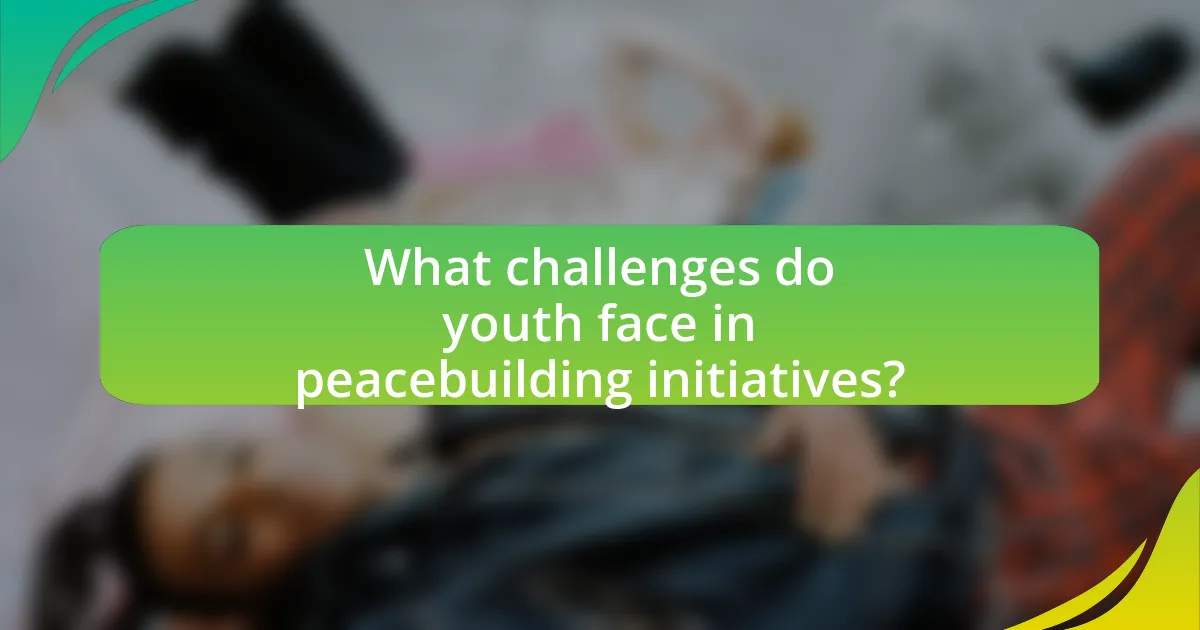
What challenges do youth face in peacebuilding initiatives?
Youth face several challenges in peacebuilding initiatives, including lack of access to resources, limited representation in decision-making processes, and societal stigma. These obstacles hinder their ability to effectively contribute to peace efforts. For instance, a study by the United Nations indicates that youth often lack funding and training opportunities, which are essential for developing skills necessary for peacebuilding. Additionally, many young individuals encounter barriers due to age-related biases, which can marginalize their voices in discussions that directly affect their communities. This combination of resource scarcity and exclusion from leadership roles significantly impedes their potential impact in fostering peace.
What barriers hinder youth participation in peace processes?
Barriers that hinder youth participation in peace processes include lack of access to decision-making platforms, limited representation in leadership roles, and societal perceptions that undervalue youth contributions. Research indicates that youth often face systemic obstacles, such as age discrimination and inadequate support from institutions, which restrict their ability to engage effectively in peacebuilding efforts. For instance, a study by the United Nations Development Programme highlights that only 1% of peace agreements include youth perspectives, demonstrating the significant gap in their involvement. Additionally, socio-economic factors, such as poverty and education disparities, further impede youth from participating in these critical processes.
How do socio-economic factors affect youth engagement in peacebuilding?
Socio-economic factors significantly influence youth engagement in peacebuilding by shaping their access to resources, education, and opportunities for participation. For instance, youth from lower socio-economic backgrounds often face barriers such as limited access to quality education and employment, which can hinder their ability to engage effectively in peacebuilding initiatives. Research indicates that in regions with high poverty rates, youth are more likely to be involved in violence rather than peace efforts, as they may perceive limited alternatives for their future (UNICEF, “The Role of Youth in Peacebuilding,” 2020). Additionally, socio-economic disparities can lead to feelings of disenfranchisement among youth, reducing their motivation to participate in peacebuilding activities. Thus, addressing these socio-economic challenges is crucial for enhancing youth involvement in peace initiatives.
What role does education play in empowering youth for peacebuilding?
Education plays a crucial role in empowering youth for peacebuilding by equipping them with the knowledge, skills, and values necessary to foster social cohesion and resolve conflicts. Through education, young individuals learn about human rights, cultural diversity, and the importance of dialogue, which are essential components for promoting peace. For instance, programs like UNESCO’s Global Education for Peace initiative demonstrate that educational frameworks can significantly reduce violence and encourage active citizenship among youth. Furthermore, research indicates that educated youth are more likely to engage in community service and advocacy, thereby contributing to sustainable peace efforts.
How can these challenges be overcome?
Youth can overcome challenges in global peacebuilding initiatives by actively engaging in dialogue, education, and community service. By participating in structured programs that promote conflict resolution and intercultural understanding, young people can develop essential skills to address and mitigate tensions. For instance, initiatives like the United Nations’ Youth, Peace and Security agenda emphasize the importance of youth involvement in decision-making processes, which has been shown to lead to more sustainable peace outcomes. Furthermore, research indicates that youth-led organizations often foster innovative solutions to local conflicts, demonstrating the effectiveness of grassroots involvement in peacebuilding efforts.
What strategies can enhance youth involvement in peace initiatives?
To enhance youth involvement in peace initiatives, strategies such as education, mentorship, and active participation in decision-making processes are essential. Education programs that focus on conflict resolution and peacebuilding equip young individuals with the necessary skills and knowledge to engage effectively. Mentorship from experienced peacebuilders can guide youth in understanding the complexities of peace initiatives and inspire them to take action. Furthermore, involving youth in decision-making processes ensures their voices are heard, fostering a sense of ownership and responsibility towards peace efforts. Research by the United Nations indicates that youth engagement in peace processes leads to more sustainable outcomes, highlighting the importance of these strategies.
How can partnerships between youth and established organizations be strengthened?
Partnerships between youth and established organizations can be strengthened by fostering open communication and collaboration on shared goals. Establishing regular dialogue through workshops and forums allows both parties to align their objectives and understand each other’s perspectives. Research indicates that youth engagement in decision-making processes enhances the effectiveness of initiatives, as seen in the United Nations’ Youth Strategy, which emphasizes the importance of youth participation in peacebuilding efforts. By creating mentorship programs, established organizations can provide guidance while youth can offer fresh insights, leading to mutually beneficial outcomes.
What are best practices for supporting youth in peacebuilding?
Best practices for supporting youth in peacebuilding include fostering inclusive dialogue, providing education and training, and facilitating access to resources. Inclusive dialogue allows youth to express their perspectives and engage in decision-making processes, which has been shown to enhance their commitment to peace initiatives. Education and training equip young people with the skills necessary for conflict resolution and leadership, as evidenced by programs like the United Nations’ Youth, Peace and Security agenda, which emphasizes the importance of youth participation in peace processes. Additionally, facilitating access to resources, such as funding and mentorship, empowers youth-led initiatives, leading to more effective and sustainable peacebuilding efforts.
How can communities foster environments conducive to youth-led initiatives?
Communities can foster environments conducive to youth-led initiatives by providing resources, mentorship, and platforms for youth engagement. Access to funding, training programs, and collaborative spaces encourages young people to develop and implement their ideas. For instance, research by the United Nations indicates that youth participation in decision-making processes leads to more effective and sustainable outcomes in community projects. Additionally, establishing partnerships with local organizations can enhance support networks, enabling youth to gain valuable skills and experience.
What resources are available to empower young peacebuilders?
Young peacebuilders can access various resources, including educational programs, mentorship opportunities, funding for initiatives, and online platforms for collaboration. Educational programs, such as those offered by organizations like the United Nations and local NGOs, provide training in conflict resolution and peacebuilding strategies. Mentorship opportunities connect young individuals with experienced peacebuilders, enhancing their skills and networks. Funding resources, such as grants from foundations like the Global Fund for Community Foundations, support youth-led projects aimed at fostering peace. Online platforms, including social media and dedicated forums, facilitate collaboration and knowledge sharing among young peacebuilders globally. These resources collectively empower youth to actively participate in and lead peacebuilding efforts.
